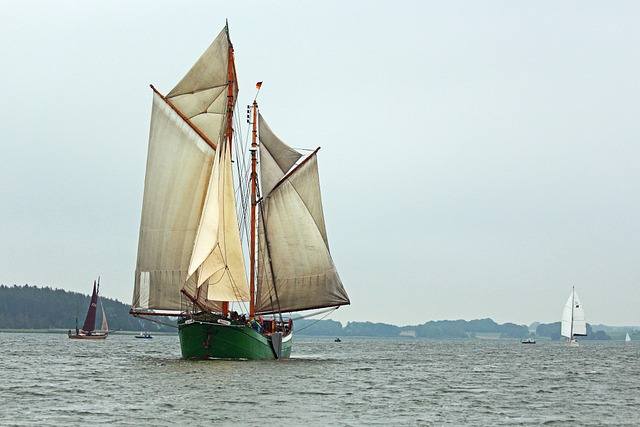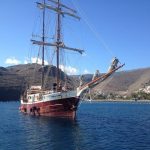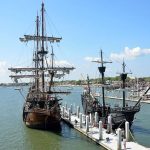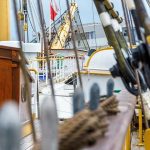At seaports, one can always witness the captivating sight of tall ships with their tall masts and billowing sails.
However, as awe-inspiring as these tall ships may be, one cannot ignore the fact that they can be dangerous places, especially in the absence of proper safety measures.
Safety is paramount on any ship, but especially on tall ships, where the risks of fire, falling, collision, and weather hazards are amplified by the height, rigging, sails, and wooden structure of the vessel.
Therefore, in this comprehensive guide, we will discuss the importance of safety measures on tall ships and why it is crucial to follow them meticulously.
The Main Safety Hazards on Tall Ships and How to Prevent Them
Tall ships are exposed to various hazards that can cause injury, damage, or even loss of life. Some of the most common hazards are:
Fire
Fire is one of the most dangerous threats on a tall ship, as it can quickly spread through the wooden hull, masts, sails, and rigging, destroying the vessel and endangering the crew and passengers.
Fire can be caused by various sources, such as electrical faults, cooking accidents, smoking materials, flammable liquids or gases, or lightning strikes.
To prevent fire on a tall ship, you should:
- Install and maintain fire detection and suppression systems, such as smoke alarms, sprinklers, fire extinguishers, fire blankets, and fire hoses.
- Keep flammable materials away from heat sources and store them in secure containers.
- Avoid using open flames or candles on board and use electric or battery-powered lighting instead.
Falling
Falling from height is another major risk on a tall ship, as the crew and passengers may have to climb the masts, yards, or rigging to perform various tasks or enjoy the view.
Falling can result in serious injuries or fatalities, especially if the person falls overboard or hits a hard surface.
To prevent falling on a tall ship, you should:
- Wear appropriate personal protective equipment (PPE), such as harnesses, helmets, gloves, and shoes with good grip.
- Use safety lines or nets when working aloft or near the edge of the deck.
- Follow the instructions and commands of the captain or the officer in charge when climbing or descending.
- Avoid climbing when the weather is bad or when the ship is moving fast or rocking heavily.
Collision
Collision with other vessels, rocks, reefs, icebergs, or other obstacles can cause severe damage to a tall ship’s hull, masts, sails, rigging, or steering system. Collision can also injure or kill the crew and passengers on board.
Collision can be caused by human error, poor visibility, navigational errors, mechanical failures, or adverse weather conditions.
To prevent collision on a tall ship, you should:
- Install and maintain navigational equipment and instruments, such as radar, GPS, AIS (Automatic Identification System), VHF radio, compasses, charts, sextants, etc.
- Follow the rules of the road (COLREGS) when sailing in busy or congested waters and communicate with other vessels using sound signals, lights, flags, or radio.
- Keep a proper lookout at all times and report any sightings or dangers to the captain or officer in charge.
The Essential Safety Equipment on Tall Ships
Tall ships should be equipped with various safety equipment to ensure the protection and survival of the crew and passengers in case of an emergency.
Some of the essential safety equipment are:
- Lifeboats and life rafts
- Life jackets and buoyancy aids
- Lifelines and liferings
- EPIRB (Emergency Position Indicating Radio Beacon)
- SART (Search And Rescue Transponder)
- Flares
The Importance of Following Safety Measures
All tall ships must have a comprehensive safety plan that they follow to ensure the crew’s and passengers’ safety. This plan should include a variety of measures such as crew training, vessel maintenance, and emergency procedures.
It is crucial for the captain and crew members to strictly follow these safety measures to prevent any accidents or injuries.
Crew Training
The crew members’ education and training are of utmost importance when it comes to ensuring ship safety. They need to be adequately trained in managing the ship, emergency procedures, and handling situations such as storms and accidents.
Proper training and drills can help prepare the crew members for critical situations and minimize the risks of accidents.
Vessel Maintenance
Tall ships, like any other ships, require proper maintenance to ensure they are in the best condition. Regular inspections and maintenance will help detect any issues before they become bigger problems.
Maintenance should include checking the conditions of the rigging, ropes, and sails, as well as the engines and the hull of the ship.
Emergency Procedures
Accidents can happen even with following strict safety measures. Therefore, every tall ship must have appropriate emergency procedures in place. The emergency procedures should be rehearsed routinely to help ensure that the crew is prepared for any emergencies or accidents.
The emergency procedures should cover a wide range of possibilities, ranging from a person overboard to a fire on board, to ensure that the crew knows what to do in any situation.
In Summary
In conclusion, tall ships can be a fantastic sight to behold, but it is essential to remember that they are potentially hazardous environments. To minimize the risks of accidents and injuries, it is crucial to follow strict safety measures.
Proper crew training, regular maintenance, and having strict emergency procedures in place are vital components of any effective safety plan on board a tall ship.
By following these safety measures, crew members and passengers can enjoy the breathtaking views provided by tall ships while remaining safe and secure.




![8 Best Tall Ship Documentaries for History Buffs [Video] 8 Best Tall Ship Documentaries for History Buffs [Video]](https://www.tallshipssunderland.com/wp-content/uploads/2023/03/tall-ship-documentaries-150x150.jpg)

![The Best Navigation Tools for Tall Ship Sailing [Ultimate Guide] The Best Navigation Tools for Tall Ship Sailing [Ultimate Guide]](https://www.tallshipssunderland.com/wp-content/uploads/2023/03/navigation-tools-150x150.jpg)